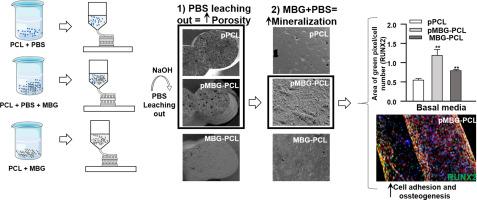Biomaterials Advances ( IF 7.9 ) Pub Date : 2020-11-06 , DOI: 10.1016/j.msec.2020.111706 M Natividad Gómez-Cerezo 1 , Juan Peña 2 , Sašo Ivanovski 1 , Daniel Arcos 2 , María Vallet-Regí 2 , Cedryck Vaquette 1

|
In order to increase the bone forming ability of MBG-PCL composite scaffold, microporosity was created in the struts of 3D-printed MBG-PCL scaffolds for the manufacturing of a construct with a multiscale porosity consisting of meso- micro- and macropores. 3D-printing imparted macroporosity while the microporosity was created by porogen removal from the struts, and the MBG particles were responsible for the mesoporosity. The scaffolds were 3D-printed using a mixture of PCL, MBG and phosphate buffered saline (PBS) particles, subsequently leached out. Microporous-PCL (pPCL) as a negative control, microporous MBG-PCL (pMBG-PCL) and non-microporous-MBG-PCL (MBG-PCL) were investigated. Scanning electron microscopy, mercury intrusion porosimetry and micro-computed tomography demonstrated that the PBS removal resulted in the formation of micropores inside the struts with porosity of around 30% for both pPCL and pMBG-PCL, with both constructs displaying an overall porosity of 80-90%. In contrast, the MBG-PCL group had a microporosity of 6% and an overall porosity of 70%. Early mineralisation was found in the pMBG-PCL post-leaching out and this resulted in the formation a more homogeneous calcium phosphate layer when using a biomimetic mineralisation assay. Mechanical properties ranged from 5 to 25 MPa for microporous and non-microporous specimens, hence microporosity was the determining factor affecting compressive properties. MC3T3-E1 metabolic activity was increased in the pMBG-PCL along with an increased production of RUNX2. Therefore, the microporosity within a 3D-printed bioceramic composite construct may result in additional physical and biological benefits.
中文翻译:

用于骨再生的介孔生物玻璃 3D 打印支架中的多尺度孔隙率
为了增加 MBG-PCL 复合支架的骨形成能力,在 3D 打印的 MBG-PCL 支架的支柱中产生了微孔,用于制造具有由中微孔和大孔组成的多尺度孔隙的结构。3D 打印赋予大孔隙,而微孔隙是通过从支柱上去除致孔剂而产生的,而 MBG 颗粒则是造成中孔隙的原因。使用 PCL、MBG 和磷酸盐缓冲盐水 (PBS) 颗粒的混合物对支架进行 3D 打印,随后将其浸出。微孔-PCL (pPCL) 作为阴性对照,研究了微孔 MBG-PCL (pMBG-PCL) 和非微孔 MBG-PCL (MBG-PCL)。扫描电子显微镜,压汞孔隙率测定法和显微计算机断层扫描表明,去除 PBS 导致在支柱内部形成微孔,pPCL 和 pMBG-PCL 的孔隙率约为 30%,两种结构的总体孔隙率都为 80-90%。相比之下,MBG-PCL 组的微孔率为 6%,总体孔隙率为 70%。在浸出后的 pMBG-PCL 中发现了早期矿化,这导致在使用仿生矿化测定时形成更均匀的磷酸钙层。微孔和非微孔试样的机械性能范围为 5 到 25 MPa,因此微孔率是影响压缩性能的决定因素。pMBG-PCL 中的 MC3T3-E1 代谢活性随着 RUNX2 产量的增加而增加。所以,


























 京公网安备 11010802027423号
京公网安备 11010802027423号